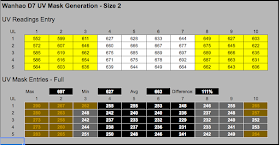Update as of 17/9/2017: This is a very flawed article as I confess in a later post here. Flawed, yet because the D7 UV light is distributed so heavily to the center, it still worked well! Sorry for any confusion and that I did not post this confession sooner (though I did make a note on the 14th)!
I finally decided to invest the effort in creating masks so that my build plate is evenly exposed to radiation from the UV LED Array of the Wanhao D7 3D Printer. The annotation on the following images explains the process. Links are at the bottom.
Note that as of 14:53 on 7/9/2017 I am chasing a little bit of under cure on the edges even with the measurements. Things are much, much better than without the mask, just not perfect!
Note that as of as of 16:24 on 14/9/2017 I need to 'fess up that my understanding of how mask generation works in NanoDLP was pretty flawed below. Stay tuned.
 |
| Printed matrix secured to the printer with the photoresistor in a cell. |
 |
| Top right is the output from the Arduino. Bottom right is the monitor built into the printer. Left is the spreadsheet that I used to calculate the mask values. |
 |
| View of the completed spreadsheet. Layer cure time will need to be increased by the stated percentage. |
 |
| Mask as generated. Located in ~/printer/public/plates on the NanoDLP instance. |
 |
| Proof is in the pudding. |
Arduino Sketch
NanoDlp Mask Calculator
Link to Mask - Use at your own risk!
Parts needed for your own measuring device:
- Photoresistor - Search for "5516 Photoresistor Sensor Detection Light Dependent Resistor". Interestingly I did not buy this for UV sensitivity but it works fine and I wonder if other photoresistors might as well. If you are reading a difference of more than 30-40% from the middle to the edges of your display it might be the photoresistor.
- 10K Resistor - Used for the other leg of a classic voltage divider.
- Arduino Uno - Search for them on eBay. You can get clones from China for a couple of quid if you are patient with shipping times.
 |
Interestingly the printer on the left has a glass plate behind the LCD and the one on the right does not.
|
 |
| Here is the test piece from my second printer. Same issue with measuring the little pointy things...there is a slight under cure at the edges. |
 |
| Calibration pieces from printer #1. First time anything has stuck to that corner! |
 |
| Closeup of the above calibration pieces. Can you tell which one was center, versus side, versus corner? |



Nice Job!
ReplyDeleteHi. Thank you for your tutorial. Can you explain me how make for know what generation is my LCD screen, i have a new D7 1.4.
ReplyDeleteThank you by advance.
Sorry, but I am not sure what you are asking! What I did above will work for any version of the D7 if you are using NanoDLP.
DeleteHi I did the same assembly but I can't get it to work.
ReplyDeleteIn the arduino the massage is different from your image.
UV: 749, 0,0
It show only random numbers
In the arduino sketch the sensor pin is wrong
Delete#define LUM 7 shoud be 5
It is 7 if the voltage divider is connected to pin 7...and 5 if it is connected to 5! The sketch post dates the above and I moved from 5 to seven...sorry! Trying to keep things interesting.
DeleteThe sketch the above article was based on was accidently updated with a more current version. I have now replaced it with the right code. Sorry for any confusion.
ReplyDeleteCould it be possible that that you are introducing the the values the wrong way ? You measure squares and the mask are rectangles
ReplyDeleteThe mask would be 5 points in with and 10 in height
You are absolutely right. I made a note to that effect on the 14th, and added another article that shows the proper orientation here: http://raspberrypirobot.blogspot.co.uk/2017/09/the-nanodlp-mask-wizard-and-wanhao-d7.html.
DeleteI did just add another note at the top of the post just to be clear that I had malfunctioned!
good job really
ReplyDeletecan I have stl which looks on that image https://1.bp.blogspot.com/-f5SiCW-C0Zg/WbFPzic6GFI/AAAAAAAAM7c/OF1UC0eJGQEK_xptKTDnfYSYriOBgIqQwCLcBGAs/s280/FullSizeRender%2B27.jpg ?
A number of masks are in the D7 Group on Facebook in addition to the ones liked to above.
Deletehttp://raspberrypirobot.blogspot.sg/2017/09/the-nanodlp-mask-wizard-and-wanhao-d7.html
ReplyDeleteThe bottom row appears to be a rectangle and not a square, meaning that the light levels on this row will be a lot less than on all the other rows ?
It is just an area to take measurement from...the mask should then be extrapolated from that measurement.
Delete